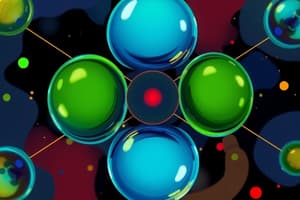Podcast
Questions and Answers
What is the primary reason scientists use models in their work?
What is the primary reason scientists use models in their work?
- Models can provide explanations for things that cannot be observed directly. (correct)
- Models replace the need for physical experimentation.
- Models can predict future scientific discoveries.
- Models are easier to understand than actual objects.
How does the particle model of matter assist in differentiating between solids, liquids, and gases?
How does the particle model of matter assist in differentiating between solids, liquids, and gases?
- It explains the behavior of particles in all three states. (correct)
- It describes the color changes in different states of matter.
- It lists the chemical properties of each state of matter.
- It identifies the temperature at which matter changes states.
Which of the following statements is true about the particle model of matter?
Which of the following statements is true about the particle model of matter?
- It helps understand the changes that occur when matter transitions between states. (correct)
- It shows how particles are static and do not move.
- It only applies to solid states of matter.
- It can be used to explain only macroscopic properties of matter.
What is the significance of using models for entities like atoms and molecules?
What is the significance of using models for entities like atoms and molecules?
Which characteristic of particles in gases differentiates them from particles in liquids?
Which characteristic of particles in gases differentiates them from particles in liquids?
What is matter?
What is matter?
Which of the following is NOT one of the states of matter?
Which of the following is NOT one of the states of matter?
Matter can exist in three states: solid, liquid, and gas.
Matter can exist in three states: solid, liquid, and gas.
The shape of a gas is fixed and does not have a fixed volume.
The shape of a gas is fixed and does not have a fixed volume.
What do scientists use models for?
What do scientists use models for?
Air is denser than a table.
Air is denser than a table.
What occurs when a substance undergoes a change in its chemical composition?
What occurs when a substance undergoes a change in its chemical composition?
Rusting of metal is an example of a physical change.
Rusting of metal is an example of a physical change.
What is the process called when a liquid changes into a gas?
What is the process called when a liquid changes into a gas?
Changing a solid into gas is called _____
Changing a solid into gas is called _____
Matter is anything that has mass and takes up space.
Matter is anything that has mass and takes up space.
Flashcards are hidden until you start studying
Study Notes
Importance of Models in Science
- Models represent concepts that are difficult to observe directly, like atoms and molecules.
- Special equipment is often required to see these tiny particles.
Particle Model of Matter
- The particle model illustrates the behavior of particles in solids, liquids, and gases.
- Provides a framework to differentiate between the three states of matter based on particle arrangement and movement.
- In solids, particles are closely packed and vibrate in fixed positions.
- In liquids, particles are close together but can move past one another, allowing flow.
- In gases, particles are far apart and move freely, filling the available space.
- Understanding particle behavior helps explain how matter transitions between states (e.g., melting, freezing, evaporation).
Introduction to Matter
- Matter occupies space and has mass, consisting of tiny particles called molecules, which are made of smaller particles known as atoms.
- Much of the physical world can be described using scientific models, including the particle model of matter.
Particle Model of Matter
- Suggests that matter is composed of tiny particles with kinetic energy, held together by attractive forces.
States of Matter
-
Solid
- Has a definite shape and volume.
- Particles are closely packed, vibrate in place, and do not flow.
- Rigid and not easily compressed.
-
Liquid
- Has a definite volume but no definite shape.
- Particles are close together but not tightly bonded, allowing them to flow.
- Takes the shape of its container.
-
Gas
- Lacks a definite shape and volume.
- Particles are in constant, rapid motion and can fill the shape of the container.
- Easily compressible.
-
Plasma
- A gas-like state consisting of positively and negatively charged particles.
- Particles have more energy compared to gases and emit energy.
Importance of Scientific Models
- Models are essential for explaining phenomena that cannot be easily observed, such as atoms and molecules, often requiring special equipment for visualization.
- The particle model helps differentiate between solids, liquids, and gases by explaining the behavior of particles and the changes that occur during state transitions.
Learning Checkpoints
- Matter can exist in three states: solid, liquid, and gas.
- The shape of a gas is not fixed, and it does not have a defined volume.
- All matter is composed of atoms, which are the fundamental particles of an element.
- Physical changes, like rusting, do not alter a substance's chemical composition.
- The transformation of a solid into a gas is not called melting; that term refers to the transition from solid to liquid.
- Boiling is the process of liquid turning into gas, while matter is defined by its mass and volume.
Studying That Suits You
Use AI to generate personalized quizzes and flashcards to suit your learning preferences.




